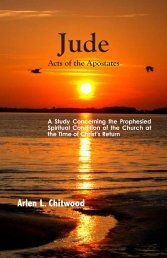Signs in John's Gospel - The Lamp Broadcast
Signs in John's Gospel - The Lamp Broadcast
Signs in John's Gospel - The Lamp Broadcast
You also want an ePaper? Increase the reach of your titles
YUMPU automatically turns print PDFs into web optimized ePapers that Google loves.
xiv SIGNS IN JOHN’S GOSPEL<br />
<strong>The</strong>n, <strong>in</strong> John 1:14, the Word becom<strong>in</strong>g “flesh” is seen <strong>in</strong> connection<br />
with two th<strong>in</strong>gs:<br />
1) Christ’s Glory.<br />
2) Christ’s Sonship, God’s Firstborn (“sonship” implies rulership,<br />
and it is firstborn sons who rule <strong>in</strong> the human realm).<br />
All of this can only take one back to the beg<strong>in</strong>n<strong>in</strong>g of God’s revelation<br />
of His Son, back to the open<strong>in</strong>g verses of Genesis. That which<br />
God desires man to know about His plans and purposes, which He<br />
will br<strong>in</strong>g to pass through His Son, beg<strong>in</strong> at this po<strong>in</strong>t.<br />
And everyth<strong>in</strong>g from this po<strong>in</strong>t forward is regal. Everyth<strong>in</strong>g has to<br />
do with God’s Son, God’s Firstborn, Who has been “appo<strong>in</strong>ted heir of<br />
all th<strong>in</strong>gs.” And everyth<strong>in</strong>g moves toward that day when God’s Son<br />
will come forth <strong>in</strong> all His Glory and realize this <strong>in</strong>heritance.<br />
<strong>The</strong> Old Testament opens this way, provid<strong>in</strong>g the complete story <strong>in</strong><br />
the open<strong>in</strong>g book. And the New Testament opens exactly the same way,<br />
provid<strong>in</strong>g commentary on the manner <strong>in</strong> which the Old Testament opens,<br />
provid<strong>in</strong>g the complete story, after another fashion, <strong>in</strong> one book as well.<br />
Scripture beg<strong>in</strong>s <strong>in</strong> Genesis with, “In the beg<strong>in</strong>n<strong>in</strong>g… [lit., ‘In beg<strong>in</strong>n<strong>in</strong>g…’],”<br />
and the New Testament beg<strong>in</strong>s exactly the same way,<br />
though a problem exists because of the manner <strong>in</strong> which man has<br />
arranged the four gospels beg<strong>in</strong>n<strong>in</strong>g the New Testament.<br />
<strong>The</strong> <strong>Gospel</strong> of John is the only gospel which beg<strong>in</strong>s the same way<br />
Genesis beg<strong>in</strong>s, “In the beg<strong>in</strong>n<strong>in</strong>g… [lit., ‘In beg<strong>in</strong>n<strong>in</strong>g…’],” along with<br />
the fact that both Genesis and John parallel one another completely,<br />
from beg<strong>in</strong>n<strong>in</strong>g to end.<br />
Thus, if the <strong>Gospel</strong> of John occupied its proper place <strong>in</strong> the arrangement<br />
of books <strong>in</strong> the New Testament, both books, Genesis and<br />
John, would not only <strong>in</strong>troduce each Testament exactly the same<br />
way but both of these books would relate the complete story of each<br />
Testament — the complete story of Scripture as a whole — at the<br />
beg<strong>in</strong>n<strong>in</strong>g of each Testament.<br />
(John’s gospel, over the years, has been the one gospel among<br />
the four which has provided problems for those arrang<strong>in</strong>g the order of<br />
the four gospels <strong>in</strong>troduc<strong>in</strong>g the New Testament. New Testaments have



